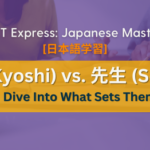Let’s Learn the Difference Between Shrines and Temples in Japan!
To understand Japanese culture, it’s important to know the difference between shrines and temples. Both are significant religious sites in Japan, but they differ in history, beliefs, and how people worship.
Today, Eri-san from JPLT Online Japanese Language School will briefly introduce the differences between these two.
What is a Shrine?
A shrine is a place based on Japan’s ancient Shinto belief. At shrines, various elements like nature and ancestors are honored as deities, and people offer prayers.
Characteristics:
-
Connection to Nature: Shrines are often located in natural settings, emphasizing the importance of nature as a deity.
-
Torii Gate: At the entrance of shrines, there is a special gate called the torii.
-
Worship Method: At shrines, people pray using the method “two bows, two claps, one bow” (ni-rei ni-haku-shu i-rei). Famous Shrines:
-
Ise Jingu (Mie Prefecture): The most important shrine in Japan.
-
Izumo Taisha (Shimane Prefecture): Famous for being the shrine of the god of relationships.
-
Atsuta Jingu (Aichi Prefecture): Houses the legendary sword “Kusanagi-no-Tsurugi.”
What is a Temple?
A temple is a place based on Buddhist teachings. Buddha statues are enshrined here, and people pray to the Buddha.
Characteristics:
-
Buddha Statue: The main feature of a temple is the statue of Buddha.
-
Worship Method: In temples, people pray silently with hands pressed together (gassho). Famous Buddhist Sects:
-
Soto Zen
-
Rinzai Zen
-
Jodo Shinshu
Differences Between Shrines and Temples
|
Category
|
Shrine (神社)
|
Temple (お寺)
|
|---|---|---|
|
Religion
|
Shinto (神道)
|
Buddhism (仏教)
|
|
What is Worshipped
|
Kami (Gods/Deities)
|
Buddha (仏像)
|
|
Building Features
|
Torii, Main Hall, Worship Hall
|
Mountain Gate, Main Hall, Buddha Statues
|
|
Worship Method
|
Two Bows, Two Claps, One Bow
|
Gassho (Hands together in prayer)
|
Commonalities:
-
Central to the Community: Both shrines and temples are important local sites and deeply tied to people’s lives.
-
Places for Prayer: People come here to make wishes and pray.
How to Distinguish Between a Shrine and a Temple:
-
Check for a Torii Gate: If there’s a torii gate, it’s a shrine. If not, it might be a temple.
-
Location: Shrines are often located in natural settings, while temples are usually found in urban areas.
Etiquette When Visiting:
-
Clothing: Wear clean clothes.
-
Language: Be quiet and show respect when worshiping.
-
Photography: Some places may prohibit photography, so check in advance.
Conclusion:
Shrines and temples are essential for understanding Japan’s culture and religion. Shrines, based on Shinto, are dedicated to nature and ancestral gods, with the worship method “two bows, two claps, one bow.” Temples, based on Buddhism, enshrine Buddha statues, and worship is done silently with hands pressed together (gassho). Despite their differences in architecture and worship practices, both are important places for local communities.
When visiting shrines or temples, it’s essential to respect the proper etiquette by maintaining silence and showing reverence. Understanding these differences will deepen your understanding of Japanese religion and culture, providing a richer experience.



